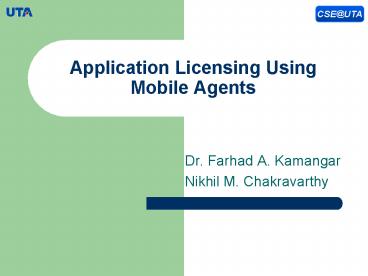Application Licensing Using Mobile Agents - PowerPoint PPT Presentation
1 / 19
Title:
Application Licensing Using Mobile Agents
Description:
Available to the User, via printed or electronic media. Stored in ... Holographic signatures. Prototype using Aglets. CSE_at_UTA. Questions? kamangar_at_cse.uta.edu ... – PowerPoint PPT presentation
Number of Views:82
Avg rating:3.0/5.0
Title: Application Licensing Using Mobile Agents
1
Application Licensing Using Mobile Agents
- Dr. Farhad A. Kamangar
- Nikhil M. Chakravarthy
2
Outline
- Software Licensing
- Problem Statement
- Proposed Solution
- Summery
- Future Work
3
Software Licensing
- Motivation.
- Revenue.
- U.S. Census bureau data in 2001.
- Revenue totaled 95.4 billion in 1999.
- Software information industry association
(SIIA). - Losses due to piracy at about 12 billion.
- Who is using it?
- Bin Laden used PGP?
4
Software Licensing
- License key.
- Available to the User, via printed or electronic
media. - Stored in software.
- Verification algorithm verifies the key.
5
Problem Statement
- License key is available to the user before
installation. - Leads to repeatable installation.
- Can analyze key to derive verification algorithm.
- Can analyze code to find stored key.
6
Current Scenario
7
Proposed Solution
- Design a licensing protocol which does not
disclose the license key to the user.
8
Proposed Scenario
9
Protocol
10
Software Fragmentation
- Two piece jig saw
- One part on server (encrypted by key K)
- One part installed
- Watermarked
- Tamper proofed
- Obfuscated
11
Machine Signature
- Parameters
- Hardware
- Network card Mac address
- Hard drive
- Memory
- Video card
- Software
- Operating system
- Domain name / IP
- File stamps
12
Deriving the Key
- Generate machine signature (ms)
- Collect user information (ui)
- Send the two to the server. I (msui)
- Select generator (G) and verifier (V) pair
- Key is generated by G. K g(i)
- Verified by V. V(K) T
13
Patching
- Send Mobile Agent. MG, ui, V
- Generate machine signature (ms)
- Reconstruct the key. K G(uims)
- Decrypt the fragment
- Complete the jig saw
- Reply / Return (Optional)
14
Sequence
Get Fingerprint
15
Summery
- User does not have access to the key.
- Mobile Agent delivers the license key.
- Software is fragmented and delivered in two
steps. - Machine signature is generated.
16
Future Work
- Machine Signature
- Loosely / Tightly Coupled
- Holographic signatures
- Prototype using Aglets
17
Questions?
- kamangar_at_cse.uta.edu
- chakrava_at_cse.uta.edu
18
References
- Collberg, C.S., Thomborson, C., Watermarking,
tamper-proofing, and obfuscation - tools for
software protection'', Software Engineering,
IEEE Transactions on , Volume 28 Issue 8 , Aug
2002 Page(s) 735 746 - James W. Stamos and David K. Gifford, Remote
Evaluation'', ACM Transactions on Programming
Languages and Systems, 12(4) 537--565, October
1990. - Giovanni Vigna (Ed.), Mobile Agents and
Security'', Lecture notes in computer science,
Vol 1419, Springer, 1998, ISBN 3-540-64792-9.
19
References
- D. B. Lange, M. Oshima, Programming and
Deploying Java Mobile Agents with Aglets'',
Addison-Wesley, 1998. - Bruce Schneier, Applied Cryptography
Protocols, Algorithms, and Source Code in C 2nd
Edition'', Publishers John Wiley Sons, Inc.
ISBN 0-471-12845-7.































